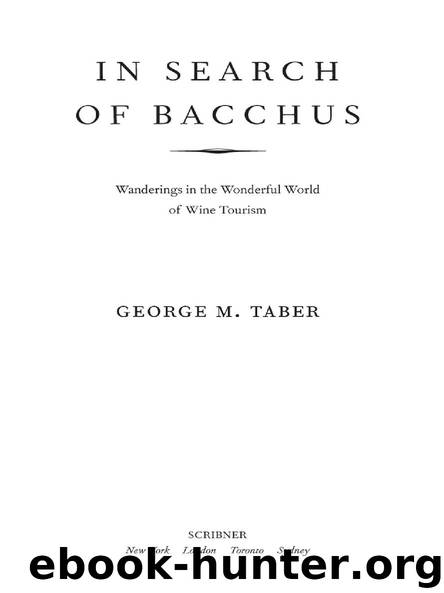IN SEARCH OF BACCHUS by GEORGE M. TABER

Author:GEORGE M. TABER
Language: eng
Format: epub
Publisher: SCRIBNER
Published: 2009-07-15T00:00:00+00:00
CHAPTER EIGHT
Rioja, Spain
During the Middle Ages, Rioja in northern Spain was the crossroads of civilizations. The cathedral of Santiago de Compostela in Galicia, a short distance west on the Atlantic Coast, was believed to be the burial site of St. James the Great, one of the original twelve apostles. Christians could earn complete forgiveness for their sins by making the pilgrimage to the cathedral along a route that became known as El Camino de Santiago (The Road to Santiago). The pious faithful walked the long trip from as far north as England and Germany down through France and then across the top of the Iberian Peninsula to Santiago. At the time, the more intellectually advanced Moors ruled most of Iberia, and they passed along their learning to less educated Europeans making the trip. A whole pilgrimage infrastructure grew up to support the travelers. Monasteries along the way became the Holiday Inns of their time, taking in pilgrims and giving them a meal, a glass of wine, and a place to sleep for a night before sending them on their way in the morning. Religious orders also established hospitals to take care of injured or ill pilgrims. At the Yuso monastery in the village of San Millán de la Cogolla, a monk in the thirteenth century carefully noted on parchment and in Latin that pilgrims there had received a meal and “a glass of good wine.” In the margin, he wrote the same notation in the local dialect that would later become the Spanish language. Thus, history’s first written record in Spanish was on the subject of wine. The people of Rioja still claim that their culture of food, wine, and hospitality goes back to the monks helping pilgrims on their way to Santiago de Compostela.
Rioja extends from the town of Alfaro in the east some 75 miles to Haro in the west, and at its broadest point is about 25 miles wide. A region of relatively small towns, the biggest nearby metropolitan area is the port city of Bilbao about 90 miles to the north. The Ebro River—Spain’s most voluminous, although relatively small compared to rivers in other countries—flows through Rioja from west to east before emptying into the Mediterranean. The name Rioja comes from an Ebro tributary named the Rio Oja, or Oja River. The large Ebro delta is a rich agricultural area, producing bountiful crops of grains, fruits, and vegetables. Rioja, though, is best for growing wine grapes. The area gets its mild climate from two mountain ranges, the tree-lined Sierra de Cantabria in the north, which protects it from harsh Atlantic winds, and the snow-peaked Sierra de la Demanda to the south, which shields it from hot, dry winds blowing out of Africa and sweeping across the Iberian plains.
Grapes grow mainly in the broad valley between the two mountain ranges. Looking out at Rioja, a visitor sees a land of browns and reds, with vineyards covering the undulating countryside leading up to high mountains in the distance.
Download
This site does not store any files on its server. We only index and link to content provided by other sites. Please contact the content providers to delete copyright contents if any and email us, we'll remove relevant links or contents immediately.
| Buying Guides | Cellars |
| Champagne | Collecting |
| Spirits | Whiskey |
| Wine | Wine Pairing |
| Wine Tasting |
Whiskies (Collins Gem) by dominic roskrow(42185)
101 Whiskies to Try Before You Die by Ian Buxton(42149)
Whiskies Galore by Ian Buxton(40299)
Craft Beer for the Homebrewer by Michael Agnew(17439)
Right Here, Right Now by Georgia Beers(3493)
Not a Diet Book by James Smith(2715)
Water by Ian Miller(2579)
The Coffee Dictionary by Maxwell Colonna-Dashwood(2527)
Kitchen confidential by Anthony Bourdain(2298)
Coffee for One by KJ Fallon(2002)
Smuggler's Cove: Exotic Cocktails, Rum, and the Cult of Tiki by Martin Cate & Rebecca Cate(1977)
Beer is proof God loves us by Charles W. Bamforth(1914)
Superfood Smoothie Bowls: Delicious, Satisfying, Protein-Packed Blends that Boost Energy and Burn Fat by Chace Daniella(1898)
Talking as Fast as I Can by Lauren Graham(1827)
Bourbon: A Savor the South Cookbook by Kathleen Purvis(1787)
A Short History of Drunkenness by Forsyth Mark(1715)
Eat With Intention by Cassandra Bodzak(1684)
Cocktails for the Holidays by Editors of Imbibe magazine(1623)
Colombia Travel Guide by Lonely Planet(1606)
